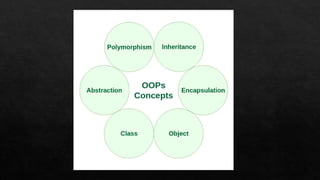Ad
Unit 1 – Introduction to Java- (Shilpa R).pptx
- 1. Unit 1 – Introduction to Java
- 2. Contents History and Evolution of Java Fundamentals of Object Oriented Programming – OOP’s Paradigm, basic concepts, benefits and application. Java vs C vs C++ Overview of Java- Simple program Platform independent nature of Java- JDK, Java interpreter, bytecode, JVM, JRE. Features of Java
- 3. History and Evolution of Java Java was originally developed by James Gosling and his team at Sun Microsystems. It was released in May 1991. This language was initially called “Oak” but was renamed “Java” in 1995. The primary motivation for was a need for a platform-independent language. Initially, Sun microsystems released JDK 1.0 in 1997 and the following versions were released in the later years. in 2010, Oracle acquired the ownership of Java. As of June 2024, Java 22 is the latest released Java version. In September 2024, Java 23 will follow.
- 4. Fundamentals of Object Oriented Programming. Object-oriented programming (OOP) is a programming paradigm based on the concept of objects, which can contain data and code: data in the form of fields (often known as attributes or properties), and code in the form of procedures (often known as methods). In OOP, computer programs are designed by making them out of objects that interact with one another. An Object has properties and behaviors. Properties are described by using data, and behaviors are described by using method. Objects are defined by using classes in Java. Java is Object-Oriented because java programming is centered on creating objects, manipulating objects and making objects work together.
- 6. Object Oriented Programming - Paradigms Class: A blueprint or template for creating objects. It defines a type of object and encapsulates data and methods that operate on that data. Example: class Car { } Object: An instance of a class. It represents a concrete entity with state and behavior. Example: Car myCar = new Car();
- 7. // Define a class named Greeting class Greeting { // Method to print "Hello, World!" void sayHello() { System.out.println("Hello, World!"); } } // Main class public class HelloWorld { public static void main(String[] args) { // Create an object of the Greeting class Greeting greeting = new Greeting(); // Call the sayHello method on the Greeting object greeting.sayHello(); } }
- 8. Abstraction in Java is the process in which we only show essential details/functionality to the user. The non-essential implementation details are not displayed to the user. The interface in Java is a mechanism to achieve abstraction. Encapsulation in Java is a fundamental concept in object-oriented programming (OOP) that refers to the bundling of data and methods that operate on that data within a single unit, which is called a class in Java.
- 9. Inheritance allows one class (subclass or derived class) to inherit the attributes and methods from another class (superclass or base class). This promotes code reusability and establishes a natural hierarchy. Polymorphism allows us to perform a single action in different ways. In other words, polymorphism allows you to define one interface and have multiple implementations. The word “poly” means many and “morphs” means forms, So it means many forms.
- 10. Benefits 1. Code Reusability: Inheritance supports the reusability of code. 2. Simple Troubleshooting: the data and the methods that operate on it are kept together in the same class, allowing for easier organization and debugging of the code. 3. Prevents Data Redundancy: Using encapsulation, OOPs help reduce data redundancy by allowing to reuse of data in multiple classes. This means that without having to rewrite, the same data can be used in multiple classes. 4. Modularity: Modularity helps break down complex code into smaller, more manageable chunks..
- 11. 5. Code Maintenance: OOPs provide tools such as inheritance, abstraction, and encapsulation that make it easier to modify, maintain, and debug code. 6. Code Security: Data abstraction and encapsulation in Java provide security advantages by allowing the user to restrict access to certain data and methods. 7. Problem-Solving Ability: Object-oriented programming (OOPS) is a powerful approach to solving complex problems by breaking them down into smaller, bite-sized components. It enables modules with the same interface to replace smaller codes. This approach enables efficient problem-solving and improved overall performance
- 12. OOP’s- Applications 1. Client-Server Systems 2. Object-Oriented Databases 3.Real-Time System Design 4.Office Automation Systems 5.CIM(Computer-Integrated Manufacturing)/CAD(Computer-Aided Design)/CAM Systems(Computer-Aided Manufacturing)
- 13. Difference between C , C++ and Java
- 14. Feature Java C C++ Memory Management Automatic garbage collection Manual (malloc/free) Manual (new/delete, with RAII) Platform Cross-platform (WORA- (JVM)) Platform-specific Platform-specific Syntax Simpler, high-level Low-level, closer to hardware Combines C-style with object- oriented features Paradigm Object-oriented Procedural Object-oriented and Procedural Inheritance Supports single inheritance Not applicable Supports multiple inheritance Standard Library Rich, with built-in classes and utilities Minimal standard library Rich, extends C library with STL (Standard Template Library) Compilation Compiled to bytecode (runs on JVM) Compiled to native machine code Compiled to native machine code Exception Handling Built-in (try/catch/finally) Not built-in Built-in (try/catch)
- 16. Documentation Section You can write a comment in this section. Package statement You can create a package with any name. A package is a group of classes that are defined by a name. It is declared as: package package_name; Import statements This line indicates that if you want to use a class of another package, then you can do this by importing it directly into your program.
- 17. Interface statement Interfaces are like a class that includes a group of method declarations. It's an optional section and can be used when programmers want to implement multiple inheritances within a program. Class Definition A Java program may contain several class definitions. Classes are the main and essential elements of any Java program. Main Method Class Every Java stand-alone program requires the main method as the starting point of the program. This is an essential part of a Java program.
- 18. public It is the visibility. This can be public, private, protected or (if you omit a value) default static It is a special [optional] keyword that indicates that this method can be called without creating an instance of this class. Without it, you have to instantiate this class and call this method from the resulting object. void It is the return type of this method, indicating that this method doesn't return anything. Methods must have a return type. main It is the name of this method. Methods have to be named. The parentheses indicate that this is a method. String[] args It is a single parameter for the method. String[] is the type of the parameter, indicating an array of Strings. args is the name of the parameter. Parameters must be named.
- 19. SIMPLE PROGRAM OF JAVA /** *Hello World, first application, only output. */ public class hello { public static void main (String [] args) { System.out.println(“Hello Worldn”); } //end main }//end class
- 21. JDK, JVM, Byte code Java Development Kit (JDK) is a software development environment used for developing Java applications and applets. It includes the Java Runtime Environment (JRE), an interpreter/loader (Java), a compiler (javac), an archiver (jar), a documentation generator (Javadoc), and other tools needed in Java development. JRE stands for “Java Runtime Environment” .The Java Runtime Environment provides the minimum requirements for executing a Java application; it consists of the Java Virtual Machine (JVM), core classes, and supporting files. JVM (Java Virtual Machine) is a very important part of both JDK and JRE because it is contained or inbuilt in both. Whatever Java program you run using JRE or JDK goes into JVM and JVM is responsible for executing the java program line by line, hence it is also known as an interpreter.
- 22. BYTE CODE Bytecode is program code that has been compiled from source code into low-level code designed for a software interpreter. It may be executed by a virtual machine (such as a JVM) or further compiled into machine code, which is recognized by the processor.
- 23. Features of Java 1) Simple 2) Object Oriented 3) Robust 4) Platform Independent – “WORA” 5) Secure 6) Multi Threading 7) Architectural Neutral 8) Portable 9) High Performance
- 24. THANK YOU






![// Define a class named Greeting
class Greeting {
// Method to print "Hello, World!"
void sayHello() {
System.out.println("Hello, World!");
}
}
// Main class
public class HelloWorld {
public static void main(String[] args) {
// Create an object of the Greeting class
Greeting greeting = new Greeting();
// Call the sayHello method on the Greeting object
greeting.sayHello();
}
}](https://image.slidesharecdn.com/unit1introductiontojava-shilpar-241127061152-219ae729/85/Unit-1-Introduction-to-Java-Shilpa-R-pptx-7-320.jpg)










![public
It is the visibility. This can be public, private, protected or (if you omit a value) default
static
It is a special [optional] keyword that indicates that this method can be called without
creating an instance of this class. Without it, you have to instantiate this class and call this
method from the resulting object.
void
It is the return type of this method, indicating that this method doesn't return anything.
Methods must have a return type.
main
It is the name of this method. Methods have to be named. The parentheses indicate that
this is a method.
String[] args
It is a single parameter for the method. String[] is the type of the parameter, indicating an
array of Strings. args is the name of the parameter. Parameters must be named.](https://image.slidesharecdn.com/unit1introductiontojava-shilpar-241127061152-219ae729/85/Unit-1-Introduction-to-Java-Shilpa-R-pptx-18-320.jpg)
![SIMPLE PROGRAM OF JAVA
/**
*Hello World, first application, only output.
*/
public class hello
{
public static void main (String [] args)
{
System.out.println(“Hello Worldn”);
} //end main
}//end class](https://image.slidesharecdn.com/unit1introductiontojava-shilpar-241127061152-219ae729/85/Unit-1-Introduction-to-Java-Shilpa-R-pptx-19-320.jpg)


























































